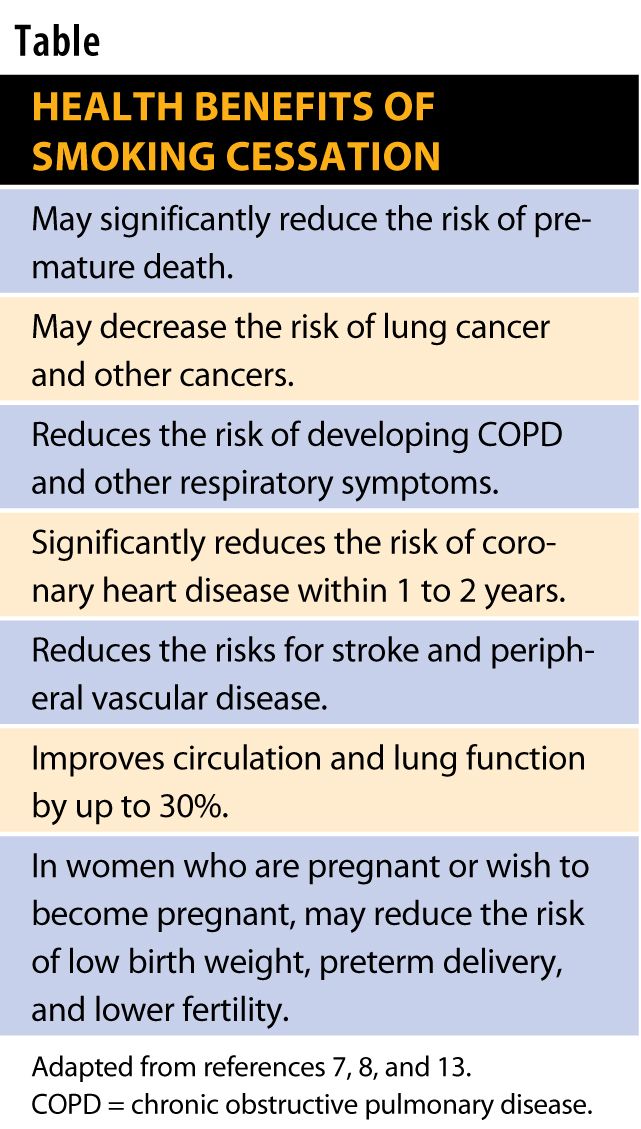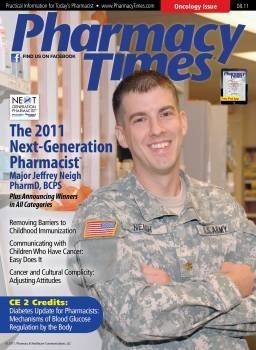Publication
Article
Pharmacy Times
Smoking Cessation
Author(s):
Helping your patients find cost-effective ways to successfully quit smoking means understanding the nonprescription products currently on the market.
Helping your patients find cost-effective ways to successfully quit smoking means understanding the nonprescription products currently on the market.
Mark Twain once said, “Quitting smoking is easy. I’ve done it a thousand times.”1 Many individuals who have attempted to quit smoking would probably agree that it is often easier said than done, and that it can be both overwhelming and challenging. Pharmacists are in a pivotal position to help patients find the most effective methods to successfully quit smoking and choose from the many nonprescription smoking cessation products currently on the market.
According to the Centers for Disease Control and Prevention (CDC), an estimated 70% of adult smokers in the United States want to stop smoking and millions have tried to quit.2 Each year, more than 13 million smokers attempt to stop, but less than 5% successfully reach their 1-year anniversary.3 One study found that 95% of “cold turkey” quitters start smoking again within 6 to 12 months.4 In the United States, tobacco use is responsible for an estimated 1 in 5 deaths each year, which equates to approximately 443,000 annual tobaccorelated deaths.5 According to the CDC, smokers die an average of 13 to 14 years earlier than nonsmokers.5
On June 21, the FDA unveiled new cigarette warning labels as part of an ongoing effort to increase awareness of the dangers of smoking, prevent or discourage children from smoking, and encourage adults who smoke to quit. Beginning in September 2012, the FDA will require larger, more prominent warnings on all cigarette packages and advertisements in the United States. The FDA hopes that these new warnings will have a profound impact on overall health by decreasing the number of individuals who smoke, increasing life expectancy, and lowering medical costs.6 More information on the new warning labels can be found at: www.fda.gov/TobaccoProducts/Labeling/ CigaretteWarningLabels/default.htm.
Benefits of Smoking Cessation
Knowing the health benefits associated with smoking cessation may help motivate many smokers to initiate a plan to successfully quit smoking (Table).

Once an individual quits smoking, he or she may notice some immediate benefits, whereas others may become more apparent over time. Examples include7:
- Breath smells better
- Stained teeth may get whiter
- Yellow color disappears from fingers and fingernails
- Food tastes better
- Sense of smell returns to normal
- Everyday activities such as climbing stairs or doing light housework no longer cause shortness of breath.
According to a 2004 publication of the Surgeon General’s Report entitled "The Health Consequences of Smoking," smoking can adversely affect almost every organ system in the body and can contribute to the manifestation of various medical conditions.8
Nicotine Replacement Therapy
One method of smoking cessation available without a prescription is nicotine replacement therapy (NRT). Available in the form of gum, patches, and lozenges, NRT products are designed to decrease the nicotine cravings and withdrawal symptoms that typically occur after abstinence from tobacco, and enable patients to focus on the behavioral modifications needed to successfully quit smoking.8-10
Nicotine Transdermal System
The nicotine transdermal system continually releases low levels of nicotine into the body over a 24-hour period.8 Transdermal products available include NicoDerm CQ with SmartControl patch (GlaxoSmithKline) and Habitrol Nicotine Transdermal System (Novartis Consumer Health), as well as generic formulations. These patches are available in 3 strengths: 7, 14, and 21 mg. Dosage is dependent upon the number of cigarettes an individual smokes daily. For example, an adult who smokes more than 10 cigarettes per day should use the 21-mg patch for 6 weeks, followed by the 14- and 7-mg patches, each for 2 weeks. Individuals who smoke fewer cigarettes may start with the 14-mg dosage for 6 weeks and then progress to 7 mg for 2 weeks.11,12
Local skin irritations such as pruritus and erythema are the most commonly reported adverse effects.8 Skin irritations can be reduced or prevented by rotating the application of patches on a daily basis. Some individuals have reported abnormal or vivid dreams, headache, or insomnia.8,11 Patients experiencing these effects should be advised to remove the patch at bedtime and apply a new patch in the morning.8
Nicotine Gum
Nicotine polacrilex gum, which is available as Nicorette (GlaxoSmithKline) and in generic form, is a resin complex of nicotine and polacrilin in a sugar-free chewing gum base containing sorbitol.8,10 The product is available in strengths of 2 and 4 mg in 6 flavors.8,10 The 2-mg dosage is recommended for individuals who smoke fewer than 25 cigarettes per day. Those who smoke more should use the 4-mg strength.8,10 Typically, the peak concentration of nicotine is achieved within 30 minutes after an individual starts to chew the gum and then slowly decreases over the next 2 to 3 hours.8
Patients should be counseled on the proper use of these products, in particular the “chew and park” method. This entails chewing the gum and then letting it sit between the gums and cheek to allow for the absorption of the nicotine, rather than just chewing the gum continuously. The most common adverse effects are unpleasant taste, dyspepsia, jaw muscle soreness, hypersalivation, hiccups, and mouth irritation.8,13
Ingestion of acidic beverages may decrease the gum’s effectiveness. Patients should not eat or drink except water for about 15 minutes before starting the gum or while chewing it. The recommended use of NRT is 1 piece of gum every 1 to 2 hours while awake during weeks 1 through 6; 1 piece every 2 to 4 hours during weeks 7 through 9; and 1 piece every 4 to 8 hours during weeks 10 through 12. No more than 24 pieces per day should be chewed.8,1
Nicotine Polacrilex Lozenges
The most common nicotine polacrilex lozenges are Nicorette Lozenges (formerly known as Commit Lozenges, GlaxoSmithKline), a resin complex of nicotine and polacrillin. Nicorette mini Lozenges (GlaxoSmithKline) are available in mint flavor and come in a portable pocket-sized package. These lozenges are available in 2- and 4-mg strengths.8,9,14 The 4-mg dose should be used by individuals who smoke their first cigarette within 30 minutes of waking up, and the 2-mg strength is for those who smoke their first cigarette more than 30 minutes after waking. 8,9,14 Although the pharmacokinetics of the gum and lozenge are comparable, the lozenge delivers approximately 25% more nicotine than the equivalent dose of nicotine gum because it can be completely dissolved.8,9,14
During the initial 6 weeks of therapy, patients should take 1 lozenge every 1 to 2 hours while awake.7,12,15 Patients can take additional dosages if needed, but should be advised to take no more than 5 lozenges in 6 hours, or 20 lozenges in a 24-hour period. The recommended dosing intervals for lozenges are similar to those of nicotine gum, as arethe associated adverse effects.8,9,12
The Role of the Pharmacist
Patients with preexisting medical conditions— including a history of myocardial infarction, severe angina, a history of arrhythmia, uncontrolled hypertension, or active peptic ulcer disease—as well as those who are pregnant or breast-feeding or are younger than 18 years should always consult their primary care provider before using any nonprescription NRT products.8 Because tobacco smoke interacts with pharmacologic agents through pharmacokinetic or pharmacodynamic mechanisms that may result in decreased therapeutic efficacy or, in rare cases, increased toxicity, pharmacists play a key role in identifying possible drug interactions and contraindications associated with tobacco use.8 Examples of drugs that may cause interactions with tobacco smoke include hormonal contraceptives, beta-blockers, theophylline, and benzodiazepines.8
Pharmacists can provide patients with suggestions of nonpharmacologic methods that can be used in conjunction with nonprescription smoking cessation products and encourage patients to seek assistance from counseling services, which can provide added motivation and increase the chances of successful smoking cessation. Patients should be advised that the combination of smoking cessation medications and counseling is more effective for smoking cessation than either medication or counseling alone.2
Ms. Terrie is a clinical pharmacy writer based in Haymarket, Virginia.
References
- What I need to know about quitting. American Cancer Society Web site. www.cancer.org/Healthy/StayAwayfromTobacco/GuidetoQuittingSmoking/guide-to-quitting-smoking-why-so-hard-to-quit. Accessed June 27, 2011.
- Smoking Cessation Centers for Disease Control Web site. www.cdc.gov/tobacco/data_statistics/fact_sheets/cessation/quitting/index.htm. Accessed June 27, 2011.
- Your physical addiction to nicotine. Nicorette Web site. www.nicorette.com/quit/habits/physical-nicotine-addiction.aspx. Accessed June 27, 2011.
- What you should know about quitting smoking: cold turkey: Nicorette Web site. www.nicorette.com/quit/habits/quit-smoking-cold-turkey.aspx. Accessed June 27, 2011.
- Smoking and tobacco use: morbidity and mortality. Centers for Disease Control Web site. www.cdc.gov/tobacco/data_statistics/fact_sheets/fast_facts/#toll. Accessed June 27, 2011.
- Guide to quitting smoking. American Cancer Society Web site. www.cancer.org/Healthy/StayAwayfromTobacco/GuidetoQuittingSmoking/guide-to-quitting-smoking-rewards. Accessed June 25, 2011.
- Cigarette health warnings. Food and Drug Administration Web site. www.fda.gov/TobaccoProducts/Labeling/CigaretteWarningLabels/default.htm. Accessed June 29, 2011.
- Kroon L, Hudmon K, Corelli R. Smoking cessation. In: Berardi R, Newton G, McDermott JH, et al. Handbook of Nonprescription Drugs. 16th ed. Washington, DC: American Pharmacists Association; 2009:894-913.
- Nicorette Mini Lozenges [product information]. GlaxoSmithKline Web site. www.nicorette.com/Products/Nicorette-mini.aspx. Accessed June 27, 2011.
- Nicorette Gum [product information]. GlaxoSmithKline Web site. www.nicorette.com/Products/Nicorette-Gum.aspx. Accessed June 27, 2011.
- Nicoderm CQ [product information]. GlaxoSmithKline Web site. www.nicodermcq.com/NicodermCQ.aspx. Accessed June 27, 2011.
- Habitrol [product information]. Novartis Consumer Health Web site. www.habitrol.com/index.html. Accessed June 27, 2011.
- 13. Health benefits of smoking cessation. Centers for Disease Control Web site. www.cdc.gov/tobacco/data_statistics/fact_sheets/cessation/quitting/index.htm#benefits. Accessed June 27, 2011.
- 14. Commit Lozenges [product information]. Glaxo Smith Kline Web site. www.commitlozenge.com/Commit.aspx. Accessed June 27, 2011.
- 15. Guide to quit smoking. American Cancer Society Web site. www.cancer.org/docroot/ped/content/ped_10_13x_guide_for_quitting_smoking.asp. Accessed June 27, 2011.







